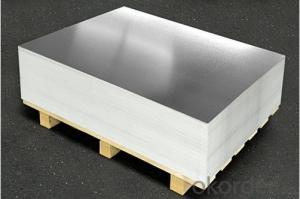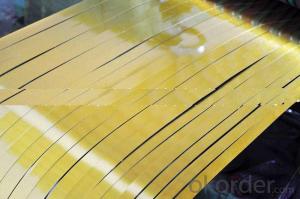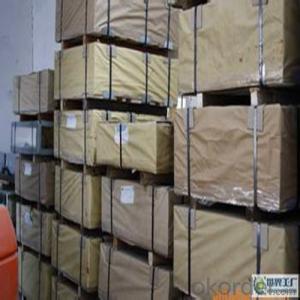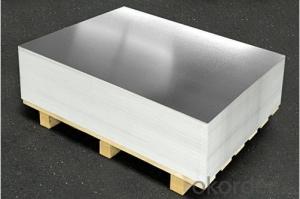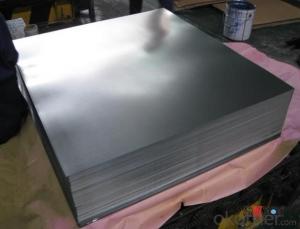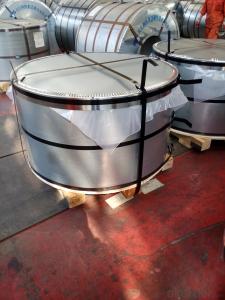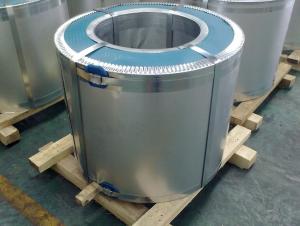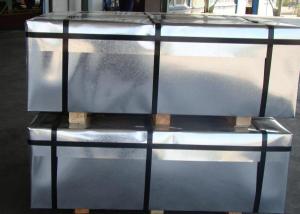Electrolytic Tinplate ETP for Metal Packages & Cans 0.22 T4 CA
- Loading Port:
- Tianjin
- Payment Terms:
- TT OR LC
- Min Order Qty:
- 25 m.t.
- Supply Capability:
- 10000 m.t./month
OKorder Service Pledge
OKorder Financial Service
You Might Also Like
1.Structure of Electrolytic Tinplate ETP for Metal Packages & Cans 0.22 T4 CA Description
Electrolytic Tinplate, is one thin steel sheet with a coating of tin applied by electrolytic deposition. Tinplate made by this process is essentially a sandwich in which the central core is strip steel. This core is cleaned in a pickling solution and then fed through tanks containing electrolyte, where tin is deposited on both sides. As the strip passes between high-frequency electric induction coils, it is heated so that the tin coating melts and flows to form a lustrous coat.
2.Main Features of the Electrolytic Tinplate ETP for Metal Packages & Cans 0.22 T4 CA
Appearance – Tinplate is characterized by its beautiful metallic luster. Products with various kinds of surface roughness are produced by selecting the surface finish of the substrate steel sheet.
Paintability and printability – Tinplates have excellent paintability and printability. Printing is beautifully finished using various lacquers and inks.
Formability and strength – Tinplates have got very good formability and strength. By selecting a proper temper grade, appropriate formability is obtained for different applications as well as the required strength after forming.
Corrosion resistance – Tinplate has got good corrosion resistance. By selecting a proper coating weight, appropriate corrosion resistance is obtained against container contents. Coated items should meet 24 hour 5 % salt spray requirement.
Solderability and weldability – Tinplates can be joined both by soldering or welding. These properties of tinplate are used for making various types of cans.
Hygienic – Tin coating provides good and non toxic barrier properties to protect food products from impurities, bacteria, moisture, light and odours.
Safe – Tinplate being low weight and high strength makes food cans easy to ship and transport.
Eco friendly – Tinplate offers 100 % recyclability.
Tin is not good for low temperature applications since it changes structure and loses adhesion when exposed to temperatures below – 40 deg C.
3.Electrolytic Tinplate ETP for Metal Packages & Cans 0.22 T4 CA Images
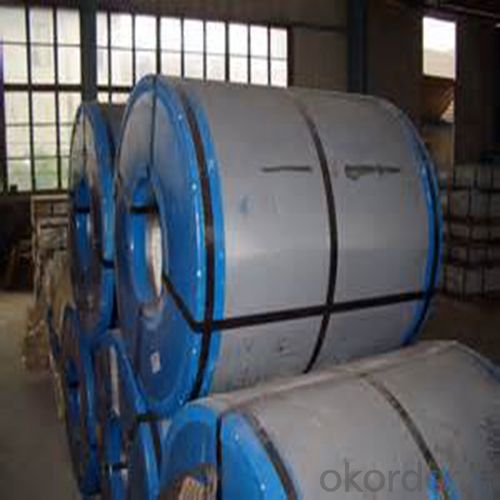

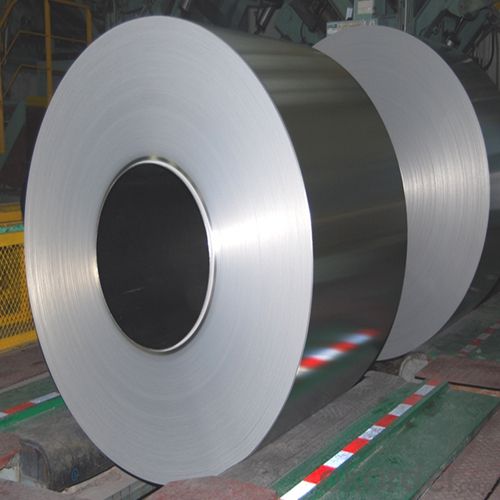
4.Electrolytic Tinplate ETP for Metal Packages & Cans 0.22 T4 CA Specification
Standard: ISO 11949 -1995
Material: MR
Thickness:0.22mm
Width: 600mm -1150mm
Temper: T4
Annealing: CA
Coil Inner Diameter: 508mm
Weight: 6-10 tons/coil 1~1.7 tons/sheets bundle
Passivation:311
Oil: DOS
Surface: Finish
5.FAQ of Electrolytic Tinplate ETP for Metal Packages & Cans 0.22 T4 CA
- How are the tinplates specified?
The tinplates are specified as per the steel base, extent of tempering, the coating weight, annealing method and the surface finish.
- How many types there are for base steels?
The base steels are of three types: Type MR, L, D
- Q: How does tinplate perform in terms of resistance to chemical agents?
- Tinplate generally exhibits good resistance to chemical agents due to the protective layer of tin coating. This coating acts as a barrier, preventing direct contact between the metal and the chemicals, thereby minimizing the risk of corrosion or chemical reactions. However, the specific performance can vary depending on the type and concentration of the chemical, as well as the duration of exposure.
- Q: What are the common misconceptions about tinplate packaging?
- One common misconception about tinplate packaging is that it is not environmentally friendly. While tinplate is made from steel, which is a finite resource, it is highly recyclable and can be reused multiple times without losing its quality. Additionally, tinplate packaging has a long shelf life, reducing the need for frequent replacement. Another misconception is that tinplate packaging is easily damaged or dented. However, modern manufacturing techniques have made tinplate packaging highly durable and resistant to external pressures, ensuring the protection of the products inside.
- Q: What are the regulations regarding the use of tinplate in food packaging?
- The regulations regarding the use of tinplate in food packaging vary depending on the country and region. However, in general, tinplate used in food packaging must comply with strict safety and quality standards. These standards often include regulations on the type and thickness of the tin coating, as well as restrictions on the presence of harmful substances, such as heavy metals. Additionally, food packaging made from tinplate may need to meet specific labeling requirements to ensure proper identification and information for consumers. It is important for manufacturers and suppliers to stay updated on the specific regulations in their respective jurisdictions to ensure compliance.
- Q: What is tin plate?
- Tin plate, also called tin plated steel plate, is formed by tin plating on the base material of the sheet steel. Sheet steel substrate with low carbon steel as raw material, its thickness is generally 0.1 ~ 0.4mm.Tin plate according to its tin plating process can be divided into two types, namely hot dipped tinplate and galvanized tinplate.
- Q: Can tinplate be used for promotional and gift items?
- Yes, tinplate can be used for promotional and gift items. Tinplate is a versatile material that can be easily decorated and customized, making it an ideal choice for creating unique and eye-catching promotional and gift items. Its durability and ability to retain its shape and design over time also make it a popular option for such purposes.
- Q: How is tinplate coated for chemical storage containers?
- Tinplate is typically coated for chemical storage containers using a process called electrolytic tin plating, where a layer of tin is electrochemically deposited onto the surface of the steel substrate. This tin coating helps to protect the container from corrosion and chemical reactions, ensuring safe storage and transportation of chemicals.
- Q: Can tinplate be used for packaging of flammable liquids?
- No, tinplate is not suitable for packaging flammable liquids as it is not resistant to corrosion and may react with the liquid, potentially causing leaks or fire hazards.
- Q: What is the purpose of tinplate coating?
- The purpose of tinplate coating is to provide a protective layer of tin on the surface of steel, preventing corrosion and enhancing the durability and longevity of the metal.
- Q: What are the advantages of using tinplate for HVAC components?
- There are several advantages of using tinplate for HVAC components. Firstly, tinplate offers excellent corrosion resistance, ensuring durability and longevity of the components even in harsh environmental conditions. Secondly, tinplate is lightweight yet strong, making it easier to handle and install. Additionally, it provides good heat conductivity, allowing for efficient heat transfer in HVAC systems. Lastly, tinplate is cost-effective and readily available, making it a cost-efficient choice for manufacturing HVAC components.
- Q: How is tinplate affected by different types of food products?
- Tinplate can be affected by different types of food products due to their varying acidity levels and ingredients. Foods that are highly acidic or contain high levels of salt can cause corrosion of the tin coating, leading to the potential transfer of tin to the food and affecting its taste and quality. Additionally, foods with strong flavors or odors can interact with the tinplate, potentially altering the taste and aroma of the food. It is important to ensure proper packaging and storage conditions to maintain the integrity of the tinplate and preserve the quality of the food product.
Send your message to us
Electrolytic Tinplate ETP for Metal Packages & Cans 0.22 T4 CA
- Loading Port:
- Tianjin
- Payment Terms:
- TT OR LC
- Min Order Qty:
- 25 m.t.
- Supply Capability:
- 10000 m.t./month
OKorder Service Pledge
OKorder Financial Service
Similar products
Hot products
Hot Searches
Related keywords












